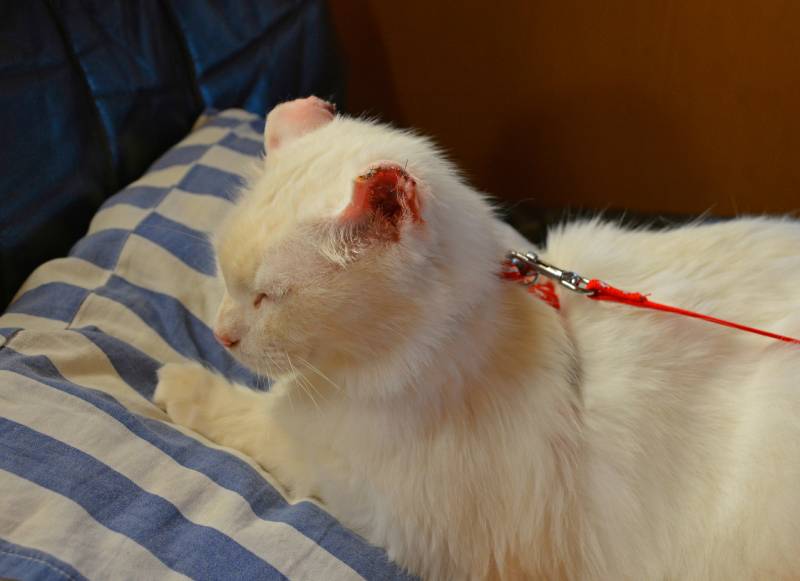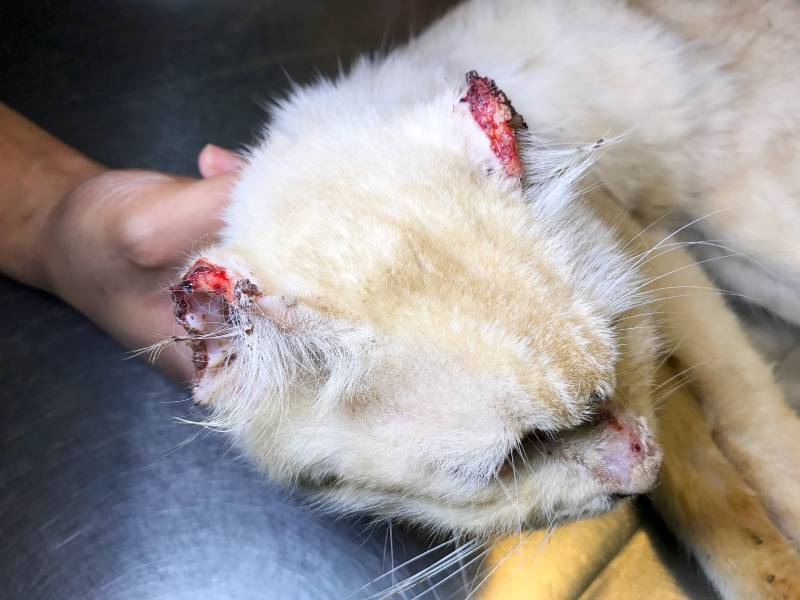Ear Cancer in Cats: Signs, Causes & Treatments (Vet Answer)

Updated on

Click to Skip Ahead
Tumors can develop anywhere on a cat’s body, including on the ear tips and inside their ears. There are many types of ear tumors in cats: squamous cell carcinoma, ceruminous gland adenocarcinomas, inflammatory polyps, earwax gland tumors, lymphoma, and fibrosarcoma, among others. The most common ear tumors in cats are squamous cell carcinomas (SCC).
This is an aggressive type of cancer that usually causes skin changes on the tips of the ears in the form of scabs, crusts, or red and inflamed non-healing wounds. This cancer can also occur in other areas, such as the mouth, nose, and eyelids. It is an invasive tumor that can affect surrounding tissues and can spread to other parts of the body in rare cases. The causes of squamous cell carcinoma are not yet fully known, but genetics and environmental factors (e.g., UV radiation) play important roles.
What Is Ear Cancer?
Cancer is a group of diseases caused by the uncontrolled growth of cells, which is triggered by mutations, or changes at the DNA level. These affect the genes, thus causing cancer cells to multiply. There are many possible factors that can lead to cancer, some of which may be from their environment, diet, exposure to carcinogenic substances, chronic inflammation, certain viral infections, genetic predisposition, hereditary factors, and more.
Cancer can occur anywhere in or on the body, including the ears. Most types of ear cancer develop on the skin of the ear tips or inside the external ear (inflammatory polyps, squamous cell carcinomas, and adenocarcinomas of the ceruminous gland).
SCC is the most common type of ear cancer found in cats. It usually occurs on the tip of the ears, but it can also be found in the middle ear, nose, mouth, toes, or eyelids. Cancers that develop in the middle or inner ear are rare. Ceruminous gland adenocarcinoma is the most common malignant tumor of the feline ear canal. When ear cancers occur inside the ear, they can also affect the surrounding bone structure.

What Are the Signs of Ear Cancer in Cats?
Even though several types of cancer (benign or malignant) can affect your cat’s ears, the clinical signs are similar and can include:
- Black or bleeding crusts and scabs on the ear tips
- Redness and inflammation that may turn into non-healing wounds and ulcers
- Visible lumps in the ear canal that can break off from being scratched at, become infected, and bleed
- Chronic or recurrent ear infections or discharge
- Waxy, pus-filled, or bloody discharge with an unpleasant smell
- Intense scratching
- Pawing at the affected ear
- Shaking of the head
- Some tumors that grow so large that they narrow or block the ear canal
If the tumor develops in the inner ear, your cat may show the following neurological signs:
- Head tilt
- Loss of balance
- Incoordination
- Circling
- Rhythmic, involuntary movements of the eyes (nystagmus)
- Facial paralysis
- Hearing loss
What Are the Causes of Ear Cancer in Cats?
Tumors are caused by changes and mutations that occur at the cellular DNA level. These can be influenced by various hereditary, genetic and environmental factors, diet, viral infections, and others.
The occurrence of some types of SCC may be favored by exposure to the sun, with white cats with short hair or those with exposed ear tips being mostly affected. Middle-aged and older cats are more likely to develop SCC, while inflammatory ear polyps are more common in cats younger than 5 years.

Polyps can develop inside the middle or the external ear canal and may only be visualized in some cases when your vet examines the cat’s ear using an otoscope. X-rays and advanced imaging may be required to confirm the diagnosis and extent of the polyp growth. Polyps can also occur in the nasopharynx, which is the back of the throat that connects with the nasal cavity above the soft palate.
How Do I Care for a Cat With Ear Cancer?
If you notice any lesions or skin changes on or in your cat’s ears or any discomfort, discharge, pain, itchiness, loss of balance, or any other signs we discussed above, take them to a veterinary clinic as soon as possible.
Unfortunately, there are no natural home remedies for treating cancer. Cats should not be left with cancerous lesions because they will not heal on their own. Instead, they will get bigger with time, may ulcerate, form open weeping wounds, or spread to surrounding tissues, all while causing pain and discomfort to your cat. It’s important to consult with a veterinarian who can examine the area and suggest adequate treatment options.
There are a few things you can do to reduce the risk of sunburn and ear tip cancer if you have a white or light-colored cat.
- Keep your cat out of the sun during peak midday and afternoon hours as much as possible, especially if your pet is white or light colored.
- Use window shades to block the sun.
- Apply a vet-approved, pet-safe sunscreen every day on the most exposed hairless skin areas, such as the ear tips and nose, making sure your cat does not lick it off.
- Take your pet to the vet promptly if they develop any skin changes or other signs that may indicate ear cancer.
- Check your cat’s ears regularly.
How Do Veterinarians Treat Ear Cancer in Cats?
After the veterinarian suspects ear cancer in your cat, they may take a fine-needle aspirate, perform a biopsy, or recommend a full excision. Most veterinarians choose surgical excision of the tumor if this is possible, as this way, a sample is obtained and tumor is removed.
For benign tumors, surgical removal should be sufficient. For malignant tumors, further treatment, such as immunosuppressant medications and chemotherapy, may be recommended, depending on the tumor type, location, size, presence of metastasis, and success of complete surgical removal with a clear margin (not leaving any cancer cells behind). When the vet cannot completely remove a tumor surgically, they may recommend radiotherapy to destroy the remaining tumor cells.
In the case of SCC, the success rate of intervention depends on location and extension of the lesions. The smaller the lesion (if caught very early), the greater the chances of surgical removal and longer cancer-free time, unless the tumor has already metastasized. If the ear tumor is not treated in time or has already grown and affected surrounding tissues, the prognosis is poorer. If the tumor can’t be removed, pain killers can be provided to ensure your cat is comfortable for as long as they have a good quality of life, while euthanasia may be recommended in advanced cases of disease.

Frequently Asked Questions (FAQs)
How Long Will a Cat Live With Ear Cancer?
If your cat has been diagnosed with ear cancer (especially SCC in the middle ear), and the tumor has been surgically removed, the average survival time may be about 6 months. In cases of ceruminous gland adenocarcinoma of the ear canal, cats may survive up to 4 years. Cats treated only with medication, chemotherapy, and/or radiation therapy may survive an average of 3 months. The survival time will vary based on the tumor type, size, location, local tumor aggressiveness, presence of metastasis, and other factors.
Is Ear Cancer in Cats Painful?
Ear cancer in cats is indeed painful. The tumor will grow and cause discomfort to your cat, which will often lead to scratching. Excessive scratching can precipitate self-mutilation and bleeding. In some cases, tumors can narrow or block the ear canal. Other clinical signs of ear cancer in cats include persistent foul-smelling discharge, shaking of the head, meowing, hearing loss, and pawing at the affected ear.

Is It Okay to Clean Cats’ Ears With Water?
No, do not clean your cat’s ears with water, as this is inappropriate. Moisture creates the perfect environment for bacterial development, and your cat can get an ear infection. Your cat may also have a ruptured eardrum, in which case many ear cleaners and topical treatments are contraindicated.
Get your cat’s ears examined by the vet, who can prescribe adequate treatment and recommend ear cleaning if this is needed. Use veterinary ear-cleaning solutions to clean your cat’s ears if your vet has suggested it, and follow their advice on the frequency and need for ear hygiene, as this will vary between cats. Most cats have clean ears and are unlikely to need any ear cleaning throughout their lives.
Conclusion
Ear cancer in cats is not very common. Cats can develop several types of ear tumors, the most common being SCC and ceruminous gland adenocarcinoma. Clinical signs of ear cancer in cats may include pain, discomfort, black crusts, scabs, bleeding, skin changes on the tips of the ears, shaking of the head, and foul-smelling discharge that may be purulent, waxy, or bloody, among many others.
If the tumor affects the inner ear, neurological signs may also occur. If your cat shows any clinical signs or a presence of a lump on or in their ears (or in other areas of the body), contact the veterinarian. Cancer of the ear, if left untreated, will get worse and significantly impact your cat’s quality of life.
Featured Image Credit: Garcia Celine, Shutterstock












